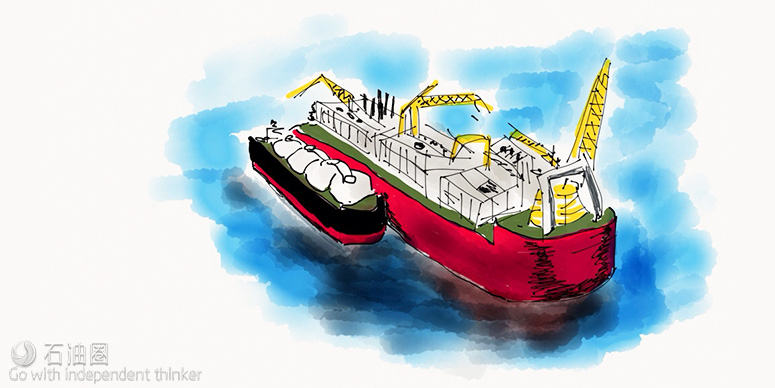In the last few years a number of hugely expensive large-scale prospects driven by major operators have fallen by the wayside or been put on hold. At the same time, interesting new prospects — mostly not in the giant category — have become contenders to fly in the future.
One vast potential floating liquefied natural gas project now in abeyance is Woodside Petroleum’s for its Browse basin area. With a price tag of at least $30 billion, that would have called for three floating units each even bigger than Shell’s Prelude.
Floating liquefaction came into the picture in September 2013 as the preferred option for this Australian development 425 kilometers north of Broome when it replaced the previous plan of piping the gas to an onshore LNG plant. The proposal was to install up to three 3.9 million tpa vessels adopting similar technology to Prelude through an agreement with partner Shell.
But that plan in turn fell by the wayside in March last year when the whole Browse project was put on hold because of the world price climate for oil and gas. Now, even though an onshore solution is still in the game, FLNG apparently remains Woodside’s preferred option for the future of this project.
However, it looks as if any floating scheme for Browse would now be smaller and more flexible than that earlier plan. A vessel output of no more than 2 million tpa looks far more likely, and would take advantage of advances in technology since Prelude kicked off.
Two months after project postponement Woodside chief executive Peter Coleman stated: “FLNG technology has already moved on significantly since Prelude, and there are designs that have improved throughput efficiency by up to 50%. Also, if you can reduce hull length to a more normal figure for shipyards of below 350 metres then you open it up to a dozen yards globally.”
Another putative Australian scheme, ExxonMobil’s Scarborough, is also out of the picture at present. When put forward this was the most ambitious such vessel proposal yet made, calling for a capacity of up to 7 million tpa and in metocean conditions lively enough to make tandem offloading essential.
Extensive pre-FEED work was carried out by a joint venture of Saipem and Chiyoda for this remote 900 metre water depth location before the price downturn put the project on hold. Now, according to a mid-January update by new partner Woodside, the group is working towards starting FEED work next year, then a final investment decision by 2020. Both floating and onshore options remain in the frame.
Off Indonesia, Inpex and Shell’s long-pursued floating proposal for Abadi (which went from 2.5 million to 7.5 million tpa in summer 2015) was abandoned last April in favour of an onshore alternative.
Future promise
However, other schemes continue to bring life to the FLNG sector, mostly off Africa. Beyond the Kribi and Fortuna projects currently in construction, another with a good chance of progress in the near future is Mozambique’s large Coral South where a FEED competition has been under way for the last two years.
Operator Eni approved Coral South in November and the partners are working towards a final investment decision in the first quarter of this year. The 3.4 million tpa vessel, expected to cost about $5 billion, would be built by a consortium of Technip, JGC and Samsung. A similar second vessel is proposed to follow for Coral North, coming on stream in 2024.
Over on Africa’s west coast, the most recent news is of the Tortue project off Senegal and Mauritania. Promoted by Kosmos and BP, this is working towards a final investment decision by next year for startup of a 2.3 million tpa vessel in 2021, followed by a second vessel two years later.
And off Congo-Brazzaville, for a location 10 kilometres from shore, UK player NewAge is currently considering bids for a vessel around 1.2 million tpa from contenders thought to include SBM, Bumi Armada, Modec and BW Offshore, on a path aiming at a start-up unlikely before 2022. NewAge is also thought to be considering a similar scale FLNG scheme for its Etinde asset off Cameroon.


 石油圈
石油圈
